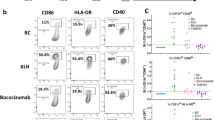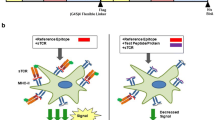Abstract
Treatment-emergent antidrug antibodies (TE-ADA) pose a major challenge to the development of biotherapeutics. The antidrug antibody responses are highly orchestrated and involve many types of immune cells and biological processes. Biological drug internalization and processing by antigen-presenting cells (APCs) are two initial and critical steps in the cascade of events leading to T cell-dependent ADA production. The assays thus far described in literature to evaluate immunogenicity potential/risk as a function of APC activity mainly focus on internalization of labeled drug candidates in vitro. Herein, we describe a high-throughput Förster Resonance Energy Transfer (FRET)-based assay for assessing both internalization and processing using CD14+ monocyte-derived dendritic cells (DCs) as APCs. Antigen-binding fragment F(ab′)2 against IgG fragment crystallizable gamma (Fcγ) was labeled with the activatable FRET pair TAMRA-QSY7 as a universal probe for antibodies and proteins with a fragment crystallizable (Fc) domain. The assay was qualified using six mAbs of known clinical immunogenicity and one IgG1 isotype antibody using Design of Experiment (DoE). Correlation analysis of internalization and clinical immunogenicity data showed that this FRET-based internalization assay was able to detect clinically immunogenic antibodies. This method provides a tool for analyzing/screening the immunogenicity risk of biological candidates by assessing one of the critical components of the ADA formation process within the broader context of an immunogenicity risk assessment strategy.








Similar content being viewed by others
References
Jawa V, Cousens LP, Awwad M, Wakshull E, Kropshofer H, De Groot AS. T-cell dependent immunogenicity of protein therapeutics: preclinical assessment and mitigation. Clin Immunol. 2013;149(3):534–55.
Rosenberg AS, Sauna ZE. Immunogenicity assessment during the development of protein therapeutics. J Pharm Pharmacol. 2018;70:584–94
Sauna ZE, Lagasse D, Pedras-Vasconcelos J, Golding B, Rosenberg AS. Evaluating and mitigating the immunogenicity of therapeutic proteins. Trends Biotechnol. 2018;36(10):1068–84.
Casadevall N, Nataf J, Viron B, Kolta A, Kiladjian JJ, Martin-Dupont P, et al. Pure red-cell aplasia and antierythropoietin antibodies in patients treated with recombinant erythropoietin. N Engl J Med. 2002;346(7):469–75.
Li J, Yang C, Xia Y, Bertino A, Glaspy J, Roberts M, et al. Thrombocytopenia caused by the development of antibodies to thrombopoietin. Blood. 2001;98(12):3241–8.
Ridker PM, Tardif JC, Amarenco P, Duggan W, Glynn RJ, Jukema JW, et al. Lipid-reduction variability and antidrug-antibody formation with bococizumab. N Engl J Med. 2017;376(16):1517–26.
Ing M, Gupta N, Teyssandier M, Maillere B, Pallardy M, Delignat S, et al. Immunogenicity of long-lasting recombinant factor VIII products. Cell Immunol. 2016;301:40–8.
Guidance for industry, immunogenicity testing of therapeutic protein products - developing and validating assays for anti-drug antibody detection. FDA. 2019.
Steinman RM. Dendritic cells: understanding immunogenicity. Eur J Immunol. 2007;37(Suppl 1):S53–60.
Iwasaki A, Medzhitov R. Control of adaptive immunity by the innate immune system. Nat Immunol. 2015;16(4):343–53.
Nutt SL, Hodgkin PD, Tarlinton DM, Corcoran LM. The generation of antibody-secreting plasma cells. Nat Rev Immunol. 2015;15(3):160–71.
De Silva NS, Klein U. Dynamics of B cells in germinal centres. Nat Rev Immunol. 2015;15(3):137–48.
Yin L, Chen X, Vicini P, Rup B, Hickling TP. Therapeutic outcomes, assessments, risk factors and mitigation efforts of immunogenicity of therapeutic protein products. Cell Immunol. 2015;295(2):118–26.
Brennan FR, Kiessling A. In vitro assays supporting the safety assessment of immunomodulatory monoclonal antibodies. Toxicol In Vitro. 2017;45(3):296–308
Quarmby V, Phung QT, Lill JR. MAPPs for the identification of immunogenic hotspots of biotherapeutics; an overview of the technology and its application to the biopharmaceutical arena. Expert Rev Proteomics. 2018;15(9):733–48.
Van Walle I, Gansemans Y, Parren PW, Stas P, Lasters I. Immunogenicity screening in protein drug development. Expert Opin Biol Ther. 2007;7(3):405–18.
De Groot AS, McMurry J, Moise L. Prediction of immunogenicity: in silico paradigms, ex vivo and in vivo correlates. Curr Opin Pharmacol. 2008;8(5):620–6.
Deora A, Hegde S, Lee J, Choi CH, Chang Q, Lee C, et al. Transmembrane TNF-dependent uptake of anti-TNF antibodies. MAbs. 2017;9(4):680–95.
Xue L, Hickling T, Song R, Nowak J, Rup B. Contribution of enhanced engagement of antigen presentation machinery to the clinical immunogenicity of a human interleukin (IL)-21 receptor-blocking therapeutic antibody. Clin Exp Immunol. 2016;183(1):102–13.
Ogawa M, Kosaka N, Longmire MR, Urano Y, Choyke PL, Kobayashi H. Fluorophore-quencher based activatable targeted optical probes for detecting in vivo cancer metastases. Mol Pharm. 2009;6(2):386–95.
Breij EC, de Goeij BE, Verploegen S, Schuurhuis DH, Amirkhosravi A, Francis J, et al. An antibody-drug conjugate that targets tissue factor exhibits potent therapeutic activity against a broad range of solid tumors. Cancer Res. 2014;74(4):1214–26.
Myers RH, Montgomery DC. Response surface methodology: process and product in optimization using designed experiments. 1st ed. New York: John Wiley & Sons, Inc.; 1995.
Wen Y, Waltman A, Han H, Collier JH. Switching the immunogenicity of peptide assemblies using surface properties. ACS Nano. 2016;10:9274–86.
Fromen CA, Robbins GR, Shen TW, Kai MP, Ting JPY, DeSimone JM. Controlled analysis of nanoparticle charge on mucosal and systemic antibody responses following pulmonary immunization. Proc Natl Acad Sci. 2015;112(2):488–93.
Lamberth K, Reedtz-Runge SL, Simon J, Klementyeva K, Pandey GS, Padkjaer SB, et al. Post hoc assessment of the immunogenicity of bioengineered factor VIIa demonstrates the use of preclinical tools. Science translational medicine. 2017;9(372):eaag1286
Spindeldreher S, Maillere B, Correia E, Tenon M, Karle A, Jarvis P, et al. Secukinumab demonstrates significantly lower immunogenicity potential compared to ixekizumab. Dermatol Ther (Heidelb). 2018;8(1):57–68.
Hughes CE, Benson RA, Bedaj M, Maffia P. Antigen-presenting cells and antigen presentation in tertiary lymphoid organs. Front Immunol. 2016;7:481.
Jakubzick CV, Randolph GJ, Henson PM. Monocyte differentiation and antigen-presenting functions. Nat Rev Immunol. 2017;17(6):349–62.
Roche PA, Furuta K. The ins and outs of MHC class II-mediated antigen processing and presentation. Nat Rev Immunol. 2015;15(4):203–16.
Acknowledgments
The authors would like to thank Weiming Li for his help on microscopic study. The authors would like to thank Richard E. Higgs and John M. Beals for critically reviewing the manuscript. The authors would like to thank Robert J. Konrad, Jirong Lu, Jack Ragheb, and Nicoletta Bivi for their helpful discussions.
Author information
Authors and Affiliations
Corresponding author
Ethics declarations
Conflict of Interest
Yi Wen, Suntara Cahya, Wei Zeng, Joanne Lin, Xiaoli Wang, Ling Liu, Laurent Malherbe, Robert Siegel, Andrea Ferrante, and Arunan Kaliyaperumal are employees of Eli Lilly and Company and may own Lilly stocks or stock options.
Additional information
Publisher’s Note
Springer Nature remains neutral with regard to jurisdictional claims in published maps and institutional affiliations.
Electronic Supplementary Material
ESM 1
(DOCX 66 kb)
Rights and permissions
About this article
Cite this article
Wen, Y., Cahya, S., Zeng, W. et al. Development of a FRET-Based Assay for Analysis of mAbs Internalization and Processing by Dendritic Cells in Preclinical Immunogenicity Risk Assessment. AAPS J 22, 68 (2020). https://doi.org/10.1208/s12248-020-00444-1
Received:
Accepted:
Published:
DOI: https://doi.org/10.1208/s12248-020-00444-1




